Rotator cuff tears
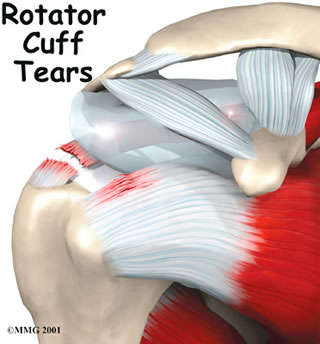
What is a rotator cuff tear?
The rotator cuff tendons surround the shoulder joint and are crucial in making it function normally. They are subject to a lot of wear and tear, or degeneration, as we use our arms. Tears occur when the tendon becomes so damaged that it loses its connection to the bone.
What is the rotator cuff?
The shoulder is made up of three bones: the scapula (shoulder blade), the humerus (upper arm bone), and the clavicle (collarbone). The rotator cuff surrounds the shoulder joint and is formed by the tendons of four muscles: the supraspinatus, infraspinatus, teres minor, and subscapularis. Tendons attach muscles to bones. Muscles move the bones by pulling on the tendons. The rotator cuff helps raise and rotate the arm. As the arm is raised, the rotator cuff also keeps the humerus tightly in the socket of the scapula. The upper part of the scapula that makes up the roof of the shoulder is called the acromion.
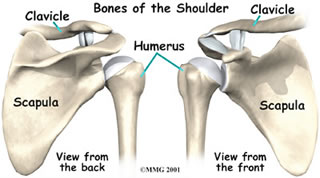
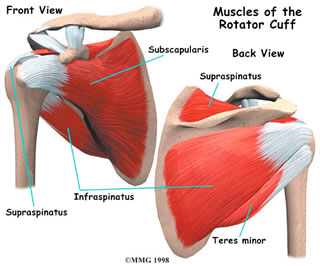
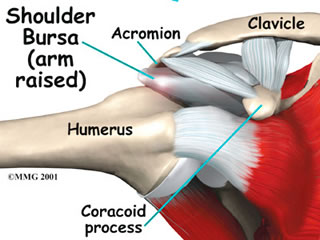 A bursa is located between the acromion and the rotator cuff tendons. A bursa is a lubricated sac of tissue that cuts down on the friction between two moving parts. Bursae are located all over the body where tissues must rub against each other. In this case, the bursa protects the acromion and the rotator cuff from grinding against each other.
A bursa is located between the acromion and the rotator cuff tendons. A bursa is a lubricated sac of tissue that cuts down on the friction between two moving parts. Bursae are located all over the body where tissues must rub against each other. In this case, the bursa protects the acromion and the rotator cuff from grinding against each other.
What causes the rotator cuff to tear?
The rotator cuff tendons have areas of very low blood supply. The more blood supply a tissue has, the better and faster it can repair and maintain itself. The areas of poor blood supply in the rotator cuff make these tendons especially vulnerable to degeneration from aging. The degeneration of aging helps explain why the rotator cuff tear is such a common injury later in life. Rotator cuff tears usually occur in areas of the tendon that had low blood supply to begin with and then were further weakened by degeneration. Repeating the same types of shoulder motions, such as cleaning windows, washing and waxing cars, or painting, may accelerate this problem of degeneration.
Excessive force can tear weak rotator cuff tendons. This force can come from trying to catch a heavy falling object or lifting an extremely heavy object with the arm extended. The force can also be from a fall directly onto the shoulder. Sometimes injuries that tear the rotator cuff are painful, but sometimes they aren't. Researchers estimate that up to 40 percent of people may have a mild rotator cuff tear without even knowing it. The typical patient with a rotator cuff tear is in late middle age and has had problems with the shoulder for some time. This patient then lifts a load or suffers an injury that tears the tendon. After the injury, the patient is unable to raise the arm. However, these injuries also occur in young people. Overuse or injury at any age can cause rotator cuff tears.
What are the symptoms?
Rotator cuff tears can cause pain and weakness in the affected shoulder. In some cases, a rotator cuff may tear only partially. The shoulder may be painful, but you can still move the arm in a normal range of motion. In general, the larger the tear, the more weakness it causes. Most rotator cuff tears cause a vague pain in the shoulder area. They may also cause a catching sensation when you move your arm. Most people say they can't sleep on the affected side due to the pain.
How is it diagnosed?
Your doctor will ask questions about your medical history, your injury, and your pain. Your doctor will then do a physical examination of the shoulder. The physical exam is most helpful in diagnosing a rotator cuff tear. A complete tear is usually very obvious. If your doctor can move the arm in a normal range of motion, but you can't move the arm yourself, you most likely have a torn rotator cuff.
X-rays won't show tears in the rotator cuff. However, your doctor may want you to have a shoulder X-ray to see if there are bone spurs, a loss of joint space in the shoulder, or a downsloping (hooked) acromion. These findings are associated with tears in the rotator cuff. An Xray can also show if there are calcium deposits in the tendon that are causing your symptoms, a condition called calcific tendonitis. Your doctor may ask you to have a magnetic resonance imaging (MRI) scan, ultrasound scan or CT scan.
What is the treatment?
Nonsurgical treatment:
Your doctor's first goal will be to help control your pain and inflammation. Initial treatment is usually rest and anti-inflammatory medication, such as aspirin or ibuprofen. This medicine is used mainly to control pain. Your doctor may suggest a cortisone injection if you have trouble getting your pain under control. Cortisone is a very effective anti-inflammatory medication. Your doctor will probably have a physiotherapist direct your rehabilitation program. At first, treatments such as heat and ice focus on easing pain and inflammation. Hands-on treatments and various types of exercises are used to improve the range of motion in your shoulder and the nearby joints and muscles. Later, you will do strengthening exercises to improve the strength and control of the rotator cuff and shoulder blade muscles. Your therapist will help you retrain these muscles to keep the ball of the humerus in the socket. This will help your shoulder move smoothly during all of your activities.
Surgical treatment:
A rotator cuff tear may require surgery if it is causing significant symptoms. Today, it is possible to repair tears of the rotator cuff using the arthroscope. An arthroscope is a special type instrument designed to look into a joint, or other space, inside the body. Using the ability to see inside the joint, the surgeon can then place other instruments into the joint and perform surgery while watching what is happening on the TV screen. The arthroscope lets the surgeon work in the joint through very small incisions. This may result in less damage to the normal tissues surrounding the joint, leading to faster healing and recovery.
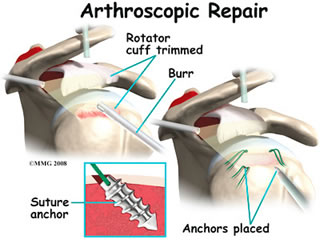
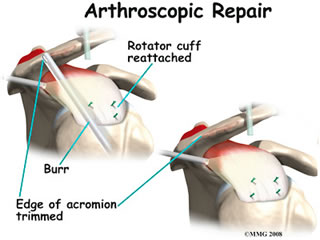
In other cases, the tendon tissue has simply worn away, and the remaining tendon is not strong enough to hold the necessary stitches. In these instances, simply removing all the torn tissue and fixing any other problems in the shoulder may reduce your pain. But this will probably not increase the strength or motion of your shoulder.
Rehabilitation after rotator cuff surgery can be a slow process. You will probably need to attend therapy sessions for two to three months, and you should expect full recovery to take up to six months. Getting the shoulder moving as soon as possible is important. However, this must be balanced with the need to protect the healing tissues. Your surgeon will most likely have you wear a sling to support and protect the shoulder for several weeks (generally four to six weeks) after surgery.
